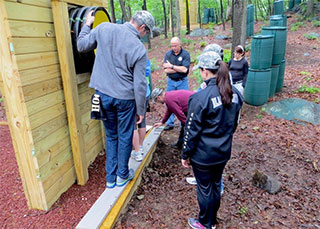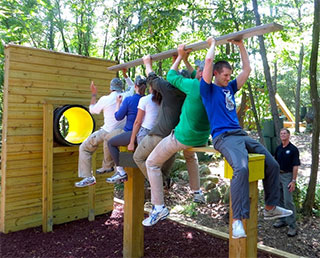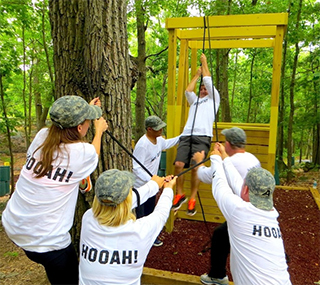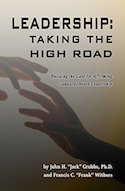Building High-Performance Teams, Before a Crisis
By Lieutenant General (Retired) Frank Kearney , Sunday, January 01, 2017

“I just need a good crisis”
I was recently working with a global, cross-functional team leader for a large client; they had just downsized, changed out critical team members, and were seeking ideas on how to rapidly build the team. The leader told me, “I just need a good crisis to catalyze and rapidly build my new team.” Of course, a crisis for your client is a risk-filled methodology to build a new team, but the idea is right on the mark. The pressure and intensity of a crisis create the heat required to meld a new team by providing: mission focus, clear purpose, rapid planning, and decisive communication in a high-pressure, must-succeed environment, which moves a new team rapidly through the form-storm-norm-perform process. Rapidly getting to know your team, their strengths and weakness, developing disciplined and rigorous processes, and communicating effectively your objectives and a common shared vision of the end-state are the positive by-products of a crisis situation. Wouldn’t it be nice to get in front of this and have your team running on all cylinders with a high degree of trust and a clear understanding of the individual and collective capabilities of the team?
“On the fields of friendly strife are sown the seed that on other days on other fields will bear the fruits of victory” — General of the Army Douglas MacArthur
In the Army, we change our leadership and teams on a routine schedule and must rapidly build teams ready to fight the nation’s wars with no warning. In the Ranger Regiment in the early 2000s, we used an exercise known as Mangudai, named for a test of Mongol warriors. It was a 3-day endurance event for all the Captains in the Regiment. Some 35 or more Captains would be stressed by lack of sleep and food deprivation while planning and executing back-to-back operations over long distances in the field. In between events, participants would take psychological and intelligence test batteries and execute peer ratings on their fellow Captains. Across the Regiment’s three geographically dispersed battalions, this forced the development of relationships in a stressful environment with leadership and duty position changes. At the end of the exercise, we had a super supper and conducted after action reviews of the event. Each Captain knew his peers across the Regiment; each other’s strengths and weaknesses; and built a foundation of trust, which served them well in future combat operations. The exercise reinforced disciplined processes and provided the leadership of the Regiment, who were present and participating, with great insights into its leaders and their level of readiness for company command.
We often have the luxury of training and creating high-intensity environments to build the team, but when time is constrained, we also teach team building and leadership through an exercise called the Leader’s Reaction Course (LRC). While not an athletic competition, it is a “field of friendly strife”, providing an alternate venue to provide a pressurized learning and team building environment. Activities like the LRC take leaders and teams and put them in an unfamiliar environment, out of their normal roles on the team, and present them with a series of problem-solving events in the form of obstacles to negotiate. Each obstacle has a scenario and requires the entire team to negotiate the obstacle and complete the task to be successful. Leadership rotates among the various obstacles to give each team member the opportunity to lead, follow, and observe. Teams rapidly go through the form-storm-norm-perform sequence and, after multiple iterations, learn each other’s strengths and weaknesses through applied problem solving in a time-pressured event. Each obstacle provides an opportunity for hasty planning, white-boarding solutions, communicating a hasty plan, defining the end state, assigning roles and responsibilities to the team, time management, executing the plan, and adjusting the plan throughout execution. Key leadership themes emphasized are: think then act, communicate precisely, use intent to empower, leverage team member strengths, mutual dependence and trust, maintain a learning orientation, leadership at the decisive point, and unity of command--one leader making the decisions.
Leadership from the Ledge
 The obstacles in the LRC present some great lessons learned on a small scale, which are timeless. Many military and corporate teams are made of high-performing, type-A personalities who want to get things done fast. Almost universally, the lesson learned on the first obstacle is “think first then act”. Pressurized by a new situation and short time to solve the challenge, there is a tendency to start acting and talk on the move, rather than to develop a hasty plan, communicate the plan, rehearse the plan (whiteboard or sand table) to leverage the entire team’s input, and ensure understanding of the plan. This inevitably leads to the majority of team members on the obstacle in some precarious situation trying to think through and solve the problem using what I call “leadership from the ledge”, a more risky style. Once the team and leaders realize they cannot achieve success, they bring the team off the obstacle and restart with far less time available to achieve the task.
The obstacles in the LRC present some great lessons learned on a small scale, which are timeless. Many military and corporate teams are made of high-performing, type-A personalities who want to get things done fast. Almost universally, the lesson learned on the first obstacle is “think first then act”. Pressurized by a new situation and short time to solve the challenge, there is a tendency to start acting and talk on the move, rather than to develop a hasty plan, communicate the plan, rehearse the plan (whiteboard or sand table) to leverage the entire team’s input, and ensure understanding of the plan. This inevitably leads to the majority of team members on the obstacle in some precarious situation trying to think through and solve the problem using what I call “leadership from the ledge”, a more risky style. Once the team and leaders realize they cannot achieve success, they bring the team off the obstacle and restart with far less time available to achieve the task.
This lesson is amplified in the learning portion of the event—the After Action Review (AAR)—that is conducted after each obstacle and is where the team reviews their performance. Teams focus on: what did we say we were going to do (the plan), what did we actually do, what caused the deviation, what did we learn, and what do we need to improve prior to the next obstacle. A series of 6 or more obstacles in a 3-4 hour period will develop trust among the team; enhance planning, communication, and learning skills for the team; and most importantly, enhance existing processes or set the team on a course to realization that disciplined processes and trust are critical to high-performance teams.
In combat, we are often presented with unplanned contingencies. In Afghanistan on the initial raid into Mullah Omar’s compound in Helmand Province, we had a helicopter strike the wall and separate the landing gear creating a hydraulic leak. The flight commander’s initial decision was to continue to fly and keep the formation together for the long flight with risk of hydraulic failure. Back at the Operations Center with a full staff using a disciplined yet hasty-planning process, we found a shorter route and tactical plan, which reduced risk and provided redundant rescue capability. The disciplined planning process produced a better option than a fully engaged Commander, who was in the middle of a combat operation, could create on the fly. It also leveraged the talent of the whole team rather than a single leader under pressure. We, too, conducted an AAR and added the lessons learned in the form of a new contingency plan to our operating procedures.
Finding the Time to Build the Team
 On any given day, the schedule is full beyond measure for most corporate teams; most agree team building and leader development are important, but the chorus is often: “where do I find the time and place to train, it’s too hard”. My military experience tells me you cannot skip any phase of the form-storm-norm-perform process required to build high-performance teams. Knowing teammates, interacting with them, and building relationships are the keys to developing and enhancing trust. This cannot be done from behind a desk or behind our daily corporate or team roles and relationships. Great teams work on team building and many, like the Army, invest in team development. Trust is the accelerant to agile organizations; commitment to teammates is a critical benefit of a team building exercise like the LRC. A few hours together in a non-work, unfamiliar environment like the LRC with a 2-hour team building session following that extracts commitments from team members to the team and charts the teams way forward; it is a single day away from the office with high payoff. I strongly encourage all organizations to get in front of the next crisis--build the new team before they are tested. Simple solutions like a Leader’s Reaction Course combine leader development, team building, and skill development in an outdoor fun setting. Add a little competition with multiple teams competing, and you intensify the opportunity for development. Team building and leader development can be a simple, inexpensive investment for your organization and fun. Put it on your team’s calendar and have fun being all you can be!
On any given day, the schedule is full beyond measure for most corporate teams; most agree team building and leader development are important, but the chorus is often: “where do I find the time and place to train, it’s too hard”. My military experience tells me you cannot skip any phase of the form-storm-norm-perform process required to build high-performance teams. Knowing teammates, interacting with them, and building relationships are the keys to developing and enhancing trust. This cannot be done from behind a desk or behind our daily corporate or team roles and relationships. Great teams work on team building and many, like the Army, invest in team development. Trust is the accelerant to agile organizations; commitment to teammates is a critical benefit of a team building exercise like the LRC. A few hours together in a non-work, unfamiliar environment like the LRC with a 2-hour team building session following that extracts commitments from team members to the team and charts the teams way forward; it is a single day away from the office with high payoff. I strongly encourage all organizations to get in front of the next crisis--build the new team before they are tested. Simple solutions like a Leader’s Reaction Course combine leader development, team building, and skill development in an outdoor fun setting. Add a little competition with multiple teams competing, and you intensify the opportunity for development. Team building and leader development can be a simple, inexpensive investment for your organization and fun. Put it on your team’s calendar and have fun being all you can be!
Lieutenant General Frank Kearney
 ExpertiseNational security, leader development, organizational change, strategic planning, training management ExperienceFrank is a 1976 graduate of the United States Military Academy. He has served in operational and command assignments at every level with combat tours in Grenada, Panama, Bosnia, Iraq and Afghanistan. He planned and participated in the opening campaigns... Read More +
ExpertiseNational security, leader development, organizational change, strategic planning, training management ExperienceFrank is a 1976 graduate of the United States Military Academy. He has served in operational and command assignments at every level with combat tours in Grenada, Panama, Bosnia, Iraq and Afghanistan. He planned and participated in the opening campaigns... Read More +

"There’s power in the art of effective communication. A leader must not only develop an easily understood vision, but he has to communicate it to his team in a way that is understandable to all."
Lieutenant General Frank Kearney
More +
"There’s power in the art of effective communication. A leader must not only develop an easily understood vision, but he has to communicate it to his team in a way that is understandable to all."
More +
"There’s power in the art of effective communication. A leader must not only develop an easily understood vision, but he has to communicate it to his team in a way that is understandable to all."
Building High-Performance Teams, Before a Crisis





